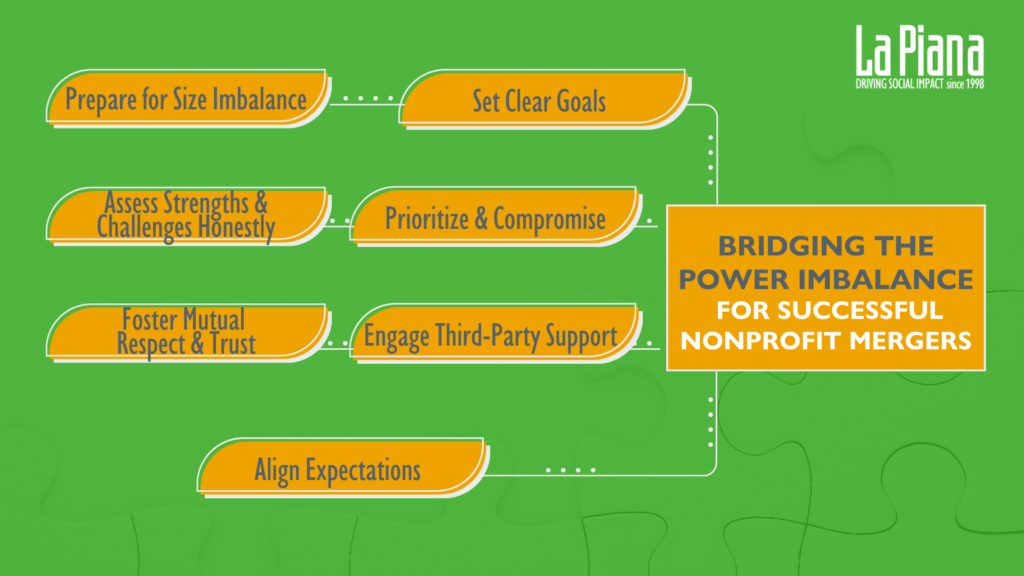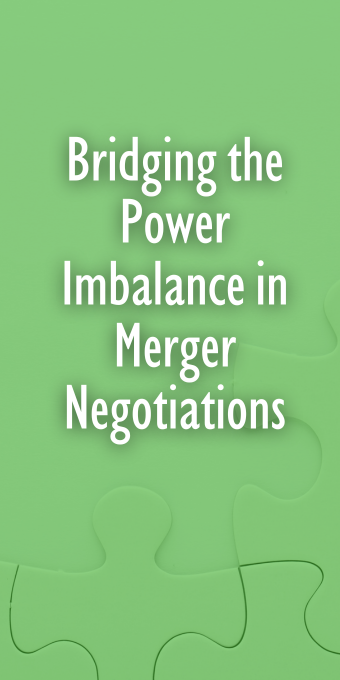Bridging the Power Imbalance in Merger Negotiations
For more than 25 years, we at La Piana Consulting have been guiding organizations through merger discussions. Our clients see the potential benefits of strategic relationships as a tool to help expand and strengthen their impact, to bring in needed skills and experience, or to create a more solid financial foundation for their work. Regardless of what brought them to the table, one common thread has emerged. Rare is the case in which two potential partners are of similar budget or staff size. Most often, a smaller organization – relatively speaking, the “minnow” — is looking to become part of one that is larger — the “whale,” or a larger organization is looking to integrate smaller counterparts.

This size imbalance often creates different expectations about what issues are important, about how decisions are to be made, and about how an integrated organization might operate. Whales often believe that, simply because they are larger, they should dictate the terms of an integration. Minnows, on the other hand, often worry that they will truly be swallowed – they’ll lose their culture and identity, their uniqueness, their way of operating, and possibly their staff and board. Failing to prepare for and close this gap in expectations can create a significant barrier to the kind of honest and comprehensive discussions needed to forge the path toward a successful relationship.
So, you ask, how can this be done? How can both potential partners enter into a negotiation with right-sized expectations that align? We’ve learned several lessons about how this can occur. First, each organization needs to be clear about its goals for a potential partnership. Are we looking for a partner because of financial issues or because we want to expand the reach of our programs? Is our executive director leaving the organization and so a merger might be preferable to an extensive search process? Do we think our programs achieve their desired impact, but we don’t have the skills or capacity to truly evaluate them? Any and all of these can be strong reasons to consider a strategic relationship. The point is to be clear about what is driving your organization to pursue a relationship at this time. If you’re an executive director, discuss this with your board and perhaps members of your leadership team. If you’re a board member, raising this question with fellow board members and staff leadership is an important first step. Click here for our Motivations Worksheet and our Desired Outcomes Worksheet. Regardless, be explicit in defining your goals for a relationship.
Once you’re clear about the “why,” take the time to list out your organization’s strengths – but be honest. And remember that there are many ways for an organization to be strong beyond simply having a large budget or staff. Access a worksheet to explore usable skills and assets here. Are you “really” good at program delivery or do you just barely meet goals? Do you build a truly compelling narrative about your organization’s work for funders, or do you continue trotting out the same well-worn anecdotes? An honest and rigorous assessment of your strengths and challenges will set you up to better assess potential partners and can help you walk into a negotiation with a clear sense of what you bring to the table – regardless of whether you’re the minnow or the whale.
Similarly, be honest and authentic about your challenges, and outline those for your potential partner. This level of humility can only serve to enhance trust between potential partners and signal an openness to exploring ways in which your potential partner can help strengthen these limitations.
Next, develop a prioritized list of what’s most important, while remembering that any relationship requires compromise and acceptance of change. How do these considerations advance your Why? Do they promote your ability to sustain your impact? If not, it would be best to relegate them to secondary considerations. Think through this with our Concerns Worksheet. Key here is not simply developing this list, but defining how resolution of these issues will advance your partnership goals.
When potential partners can clearly express their rationale, their respective strengths and limitations, and the key issues they need to address in order to decide how to proceed, they increase the likelihood of aligning expectations about the benefits, structure, and operation of an integrated organization. The discussions can then be focused on issues of importance to both potential partners without assumptions being made about what does or does not need to be considered.
A word to the whales out there. All of this work will be for naught if you are not open to new thinking, new ideas, and new ways of operating. Expecting that, just because your potential partner is smaller, they should simply take on all of your characteristics, culture, processes, and systems is not a recipe for success. And surely you want the relationship to succeed – otherwise why take the time to explore it? Our experience shows that successful nonprofit relationships are built on a common vision, mutual respect, and shared trust. Failure on any of these fronts can create insurmountable barriers to a successful relationship. And so, while both sides should do what they can to support these keys to success, larger organizations are most often challenged to do so authentically. As such, it is incumbent upon you to double down on promoting these factors – honestly, authentically, and with an open heart.
And, finally, a plug for engaging third-party support to guide your strategic partnership exploration. While admittedly biased (I am a consultant doing this exact work, after all!), I’m also clear that an experienced neutral participant can push against assumptions, helping to ensure that all issues are raised, not just those of importance to the larger organization, and that all options and solutions are considered, not simply those offered by the larger organization. As a result, voices from both organizations can be heard, the power imbalance can be minimized, and the exploration would lead to a stronger outcome.


Comment section